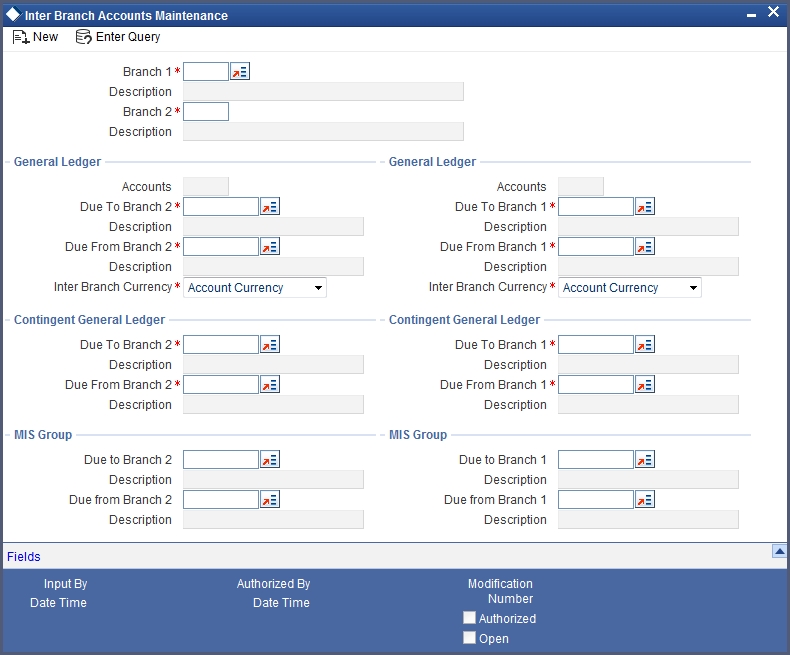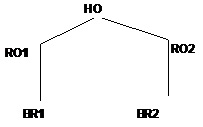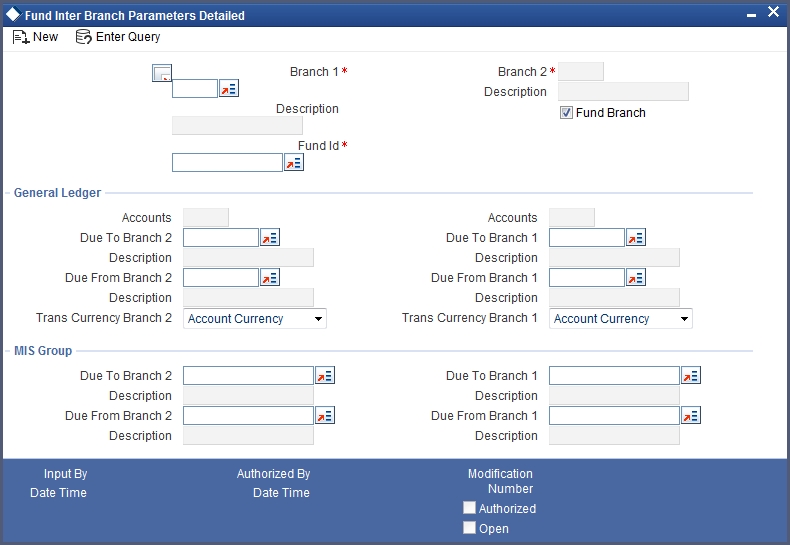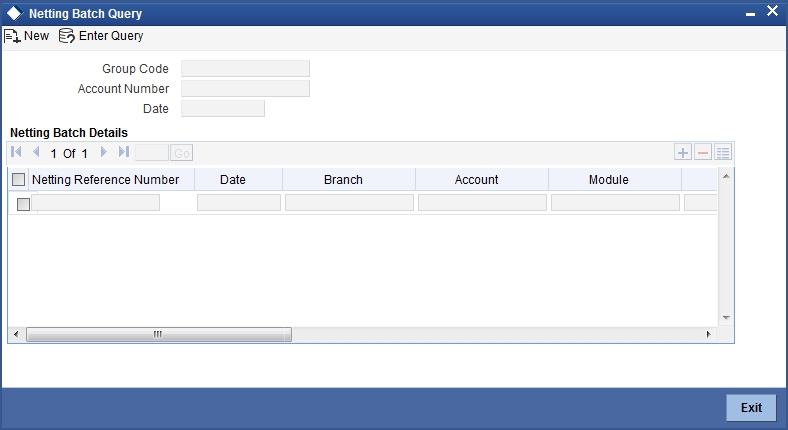10. Accounts for Inter-Branch Transactions
This chapter contains the following sections:
- Section 10.1, "Defining Accounts for Inter-Branch Transactions"
- Section 10.2, "Defining Accounts for Inter-Branch Fund Transactions"
- Section 10.3, "Querying on Netting Batch"
10.1 Defining Accounts for Inter-Branch Transactions
A transaction that takes place in a branch of your bank may involve accounts that are maintained in another branch. For example, a customer has an account in the Head Office branch and approaches another branch of the bank for a cash withdrawal.
For each combination of branches that may be involved in an inter-branch transaction, you can define the currency and the respective customer accounts to which the related accounting entries will be posted.
The accounting entries for such inter-branch transactions can be routed in one of the following ways:
- Directly - where each branch will have a direct accounting relationship with all other branches
- Through a Regional Office -- where two branches involved in a transaction will interact through a common RO
- Through the Head Office -- where the two branches involved in the inter-branch transaction will interact only through the HO.
This route for all transactions is defined in the ‘Bank parameters’ screen. In the ‘Inter-branch Parameters Maintenance’ screen you define the internal accounts for pairs of branches that would be involved in any inter-branch accounting.
Invoke this screen by typing ‘ACDIBMNT’ in the field at the top right corner of the Application tool bar and clicking the adjoining arrow button.
The screen appears as shown below:

In this screen you maintain the following for each combination of branches that may be involved in an inter-branch transaction:
- Branch Code of both the branches that are involved in the transaction
- For each of the branches, whether inter-branch entries must be posted in transaction currency or settlement account currency
- Customer accounts of Branch 1
- Due to Branch 2
- Due from Branch 2
- Customer accounts of Branch 2
- Due to Branch 1
- Due from Branch1
10.1.1 System Features
The system generates a set of pairs of branches for which internal accounts should be maintained. The pairs generated depend upon on two factors:
- The reporting structure for the branches as created in the ‘Branch parameters’ screen and
- The route defined for inter-branch transactions in the ‘Bank-wide parameters -- Preferences’ screen,
For example, the following represents the reporting structure of your bank:

If you have defined a direct inter-branch accounting route then you need to maintain an accounting relationship for each possible combination of
- Branch and branch
- Branch and RO
- RO and HO
- Branch and HO
For the above mentioned reporting structure the system will offer the following pairs of branch combinations to be maintained:
- BR1- BR2
- BR1- RO1
- BR2- RO2
- RO1- HO
- RO2- HO
- BR1 - RO2
- BR2 - RO1
- BR1 – HO
- BR2 – HO
- RO1 - RO2
If you have defined ‘through RO’ inter-branch accounting route then you need to maintain an accounting relationship for each possible combination of
- Branch and RO/HO
- RO and RO
In the branch and RO pair, the RO should be that RO to which this branch reports. For the above mentioned reporting structure the system will offer the following branch pairs to be maintained:
- BR1 - RO1
- BR2 - RO2
- RO1 – HO
- RO2 – HO
- RO1 - RO2
If you have defined ‘through HO’ inter-branch accounting route then you need to maintain an accounting relationship for each possible combination of,
- Branches and HO
- ROs and HO
For the above mentioned reporting structure the system will offer the following branch pairs to be maintained:
- HO - RO1
- HO - RO2
- HO - BR1
- HO - BR2
The system has an in-built auto escalation path for inter-branch accounting transaction which escalates from Direct to Through RO to Through HO.
For example, in the ‘Bank preferences’ screen you have defined a ‘direct’ inter-branch accounting relationship. But in the ‘Inter-branch Accounts’ maintenance screen (where all inter-branch accounts are maintained), you have not maintained an accounting relationship between two branches -- 000 and 002. Then, in case of an inter-branch accounting transaction between 000 and 002, the system will first look for a ‘direct relationship’ since that has not been maintained it will look for a relationship through RO i.e., if the two branches have a common RO; if that too does not exist then ‘through HO’ the transaction would take place.
Specifying Customer Accounts
System determines the settlement route for inter-branch transactions by considering the customer accounts that you specify for a particular currency in this screen.
For example, your bank has to processes a transaction in USD involving your branch (Branch Code 001) and another branch (Branch Code 002). If you maintain the customer accounts for the branch pair 001-002 and currency USD, system will accordingly determine the settlement route.
Branch1 and Branch2
To specify a branch pair for which you want to define the customer accounts, you can choose from a list of maintainable branch pairs displayed by the System. The description of Branch 1 and Branch 2 are displayed below the respective branch codes.
Specifying General Ledger Details
Specify the customer accounts which are involved in the inter-branch transaction, in the respective branches
To maintain customer accounts for the branch pair specified, the following parameters should be maintained:
Inter Bank Currency
For each branch, you have the option of specifying whether the inter-branch entries must be posted in the transaction currency or the settlement account currency.
For the booking branch, if the Inter-branch Transaction Currency option specified is Transaction Currency, inter-branch entries are posted in the transaction currency only if:
- The local currency of both branches involved in the transaction is the same
- One of the accounts in the entries belongs to the booking branch
Due To Branch 2
This field identifies the customer account maintained in Branch 1 into which the credit accounting entry is passed.
To specify the customer account, select the appropriate account from the picklist of all the customer accounts maintained at Branch 1 .
Due From Branch 2
This field identifies the customer account maintained in Branch 1 into which a debit entry will be passed.
Due to Branch 1
This identifies the customer account maintained at Branch 2 into which a credit entry will be passed.
Due From Branch 1
This account identifies the customer account maintained at Branch 2 into which a debit entry will be passed.
System uses the customer accounts specified in this screen and determines the settlement route for a transaction between two different branches of your bank.
10.2 Defining Accounts for Inter-Branch Fund Transactions
A fund transaction that takes place in a branch of your bank may involve accounts that are maintained in another branch.
As mentioned earlier, if you have selected the option ‘Allow Corporate Access’ in the Branch Parameters screen and the branch is a fund branch, the IB Entity will be defaulted as General Ledger. The GL that will be used will be based on the maintenance in the Fund Inter Branch Accounts Maintenance screen, for the fund id.
To invoke this screen, type ‘IADIBMNT’ in the field at the top right corner of the Application tool bar and clicking the adjoining arrow button.I

For a fund id, specify all the details necessary to define the Inter branch GL that will be used. The option list against the field Fund ID includes all the valid funds maintained in the system.
For an explanation on each of the other fields, refer to the previous section.
10.3 Querying on Netting Batch
You can view all netted and non-netted transactions of the netting process from the ‘Netting Batch Query’ screen. You can invoke this screen by typing ‘STDNETQY’ in the field at the top right corner of the Application tool bar and clicking the adjoining arrow button.

You can query on the basis of one or more of the following parameters:
- Netting Group Code
- Account Number
- Date
To view the joint holder’s details of an account and the mode of operation maintained at the account level, place the cursor on the Account Number field and press Ctrl+J. The system displays the ‘Joint Holder’ screen.
For more information on the ‘Joint Holder’ screen refer to the section ‘Joint Holder Maintenance’ in this User Manual.
On searching, the system displays the following details:
- Netting Reference Number
- Date
- Branch Code
- Account
- Module
- Event
- Reference Number
- Transaction Code
- Amount Tag
- Debit/Credit Transaction
- Account Currency
- Foreign Currency Amount
- Local Currency Amount